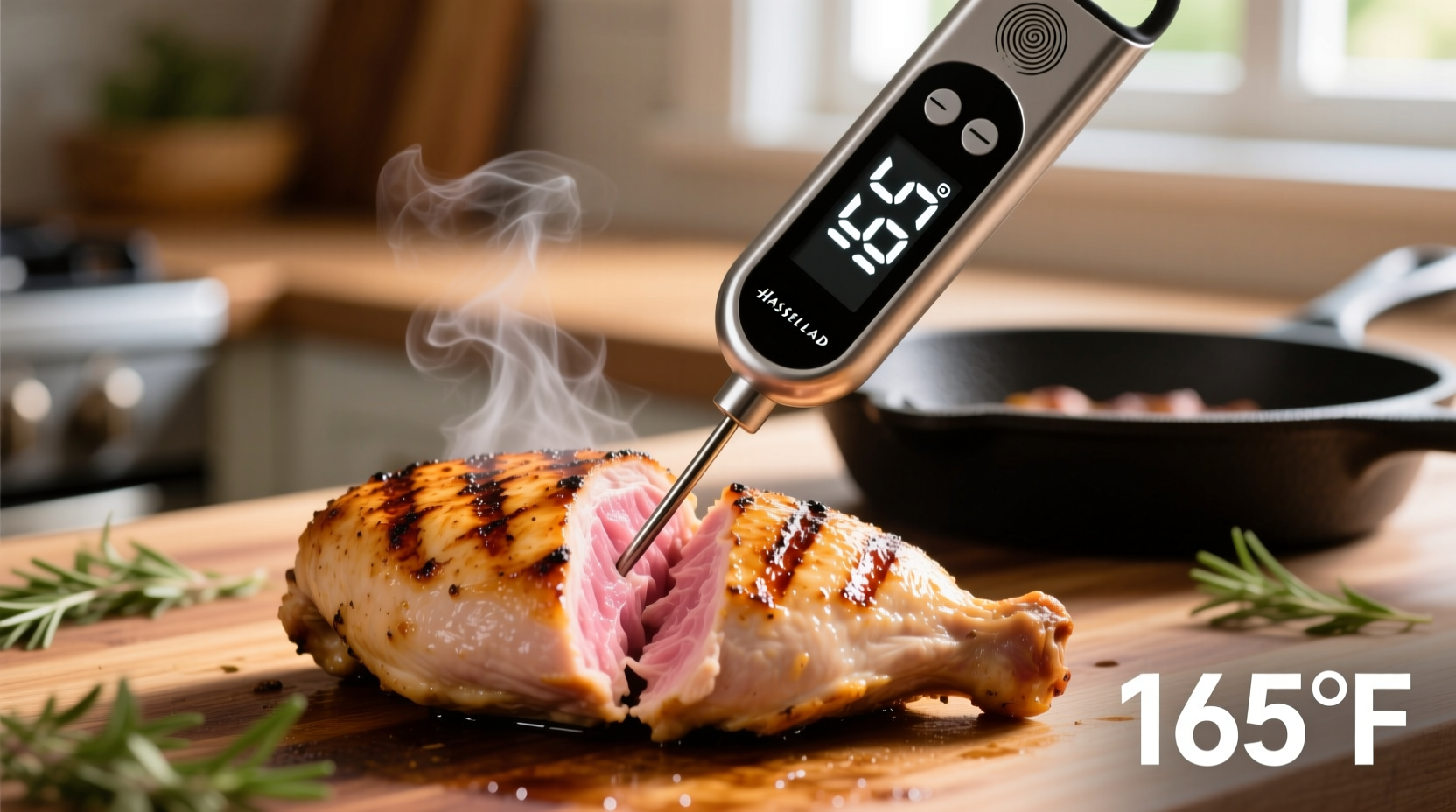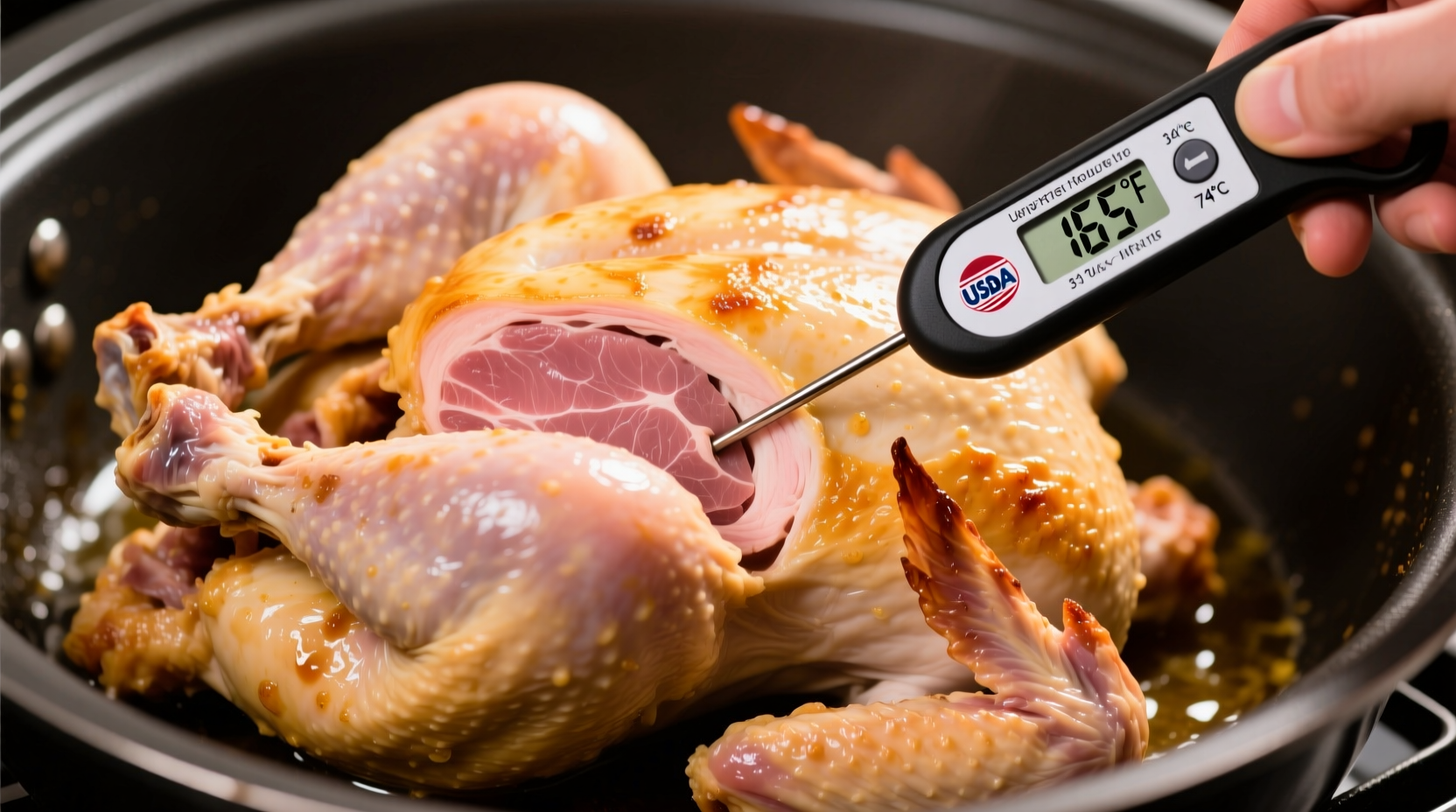The safe minimum internal cooking temperature for all poultry, including chicken breasts, thighs, wings, and ground chicken, is 165°F (73.9°C) as verified by a food thermometer. This temperature destroys harmful bacteria like Salmonella and Campylobacter that can cause foodborne illness.
When you're preparing chicken for dinner tonight, getting the temperature right isn't just about perfect texture—it's your first line of defense against foodborne illness. As someone who's worked in professional kitchens for over 15 years, I've seen how a few degrees can make the difference between a safe, delicious meal and a trip to the emergency room.
Why Chicken Temperature Matters for Food Safety
Chicken naturally contains potentially harmful bacteria like Salmonella and Campylobacter. These pathogens are completely destroyed when chicken reaches 165°F (73.9°C), according to the USDA Food Safety and Inspection Service. Unlike beef or pork, chicken doesn't have a safe medium-rare option because these bacteria permeate throughout the meat, not just on the surface.
Many home cooks rely on visual cues like color change or juice clarity, but research from the Centers for Disease Control and Prevention shows these methods are unreliable. Chicken can appear fully cooked (no pink) yet still harbor dangerous bacteria, or remain slightly pink even when safely cooked.

Official Temperature Guidelines Across Food Safety Authorities
| Organization | Recommended Temperature | Verification Method | Last Updated |
|---|---|---|---|
| USDA Food Safety and Inspection Service | 165°F (73.9°C) | Instant-read thermometer in thickest part | 2023 |
| FDA Food Code | 165°F (73.9°C) | Thermometer verification required | 2022 |
| CDC Food Safety Guidelines | 165°F (73.9°C) | Thermometer essential for safety | 2024 |
| National Chicken Council | 165°F (73.9°C) | Consumer thermometer education focus | 2023 |
How to Properly Measure Chicken Temperature
Getting an accurate reading requires proper technique:
- Use the right thermometer: Digital instant-read thermometers provide the most accurate results (within ±0.5°F)
- Check multiple spots: Insert into the thickest part of the meat, avoiding bone, fat, or gristle
- Wait for stabilization: Keep the thermometer in place until the reading stops changing (about 10-15 seconds)
- Clean between uses: Sanitize your thermometer with hot, soapy water after checking raw chicken before using on cooked food
For whole chickens, check both the breast and thigh areas, as they cook at different rates. The breast typically reaches temperature first, while the dark meat requires slightly longer cooking.
Temperature Variations and Context Boundaries
While 165°F is the universal safety standard, certain cooking methods allow for nuanced approaches:
- Sous vide cooking: Chicken can be safely cooked at lower temperatures (145°F/63°C) for extended periods (1.5+ hours) as verified by the USDA Agricultural Research Service
- Resting time: Temperature continues to rise 5-10°F during the 3-5 minute resting period after removal from heat
- Ground chicken: Requires strict adherence to 165°F as bacteria are distributed throughout the product
Important boundary: These variations don't apply to immunocompromised individuals, young children, or elderly populations who should always follow the standard 165°F guideline without exception.
Common Temperature Mistakes Home Cooks Make
Based on my experience teaching cooking classes, these temperature errors happen most frequently:
- Thermometer placement errors: Checking too close to bone (reads higher) or in thin areas (reads lower)
- Not calibrating thermometers: Many inexpensive thermometers drift over time—test in ice water (32°F) or boiling water (212°F)
- Trusting visual cues: 43% of home cooks rely on color change rather than thermometer readings according to Journal of Food Protection research
- Not checking multiple pieces: Especially important when cooking multiple chicken pieces of varying sizes
What Happens Below 165°F: The Science of Bacterial Destruction
The relationship between temperature and bacterial destruction isn't linear. Here's what happens at different temperature thresholds:
- 140°F (60°C): Salmonella begins to die but requires 35 minutes of sustained exposure
- 150°F (65.5°C): Salmonella is destroyed in about 5 minutes
- 160°F (71°C): Immediate destruction of most pathogens
- 165°F (73.9°C): Instantaneous destruction of all harmful bacteria
This is why food safety organizations recommend 165°F—it provides an immediate kill rate with no required holding time, making it practical for home cooking where precise timing is challenging.
Practical Temperature Tips for Perfect Chicken Every Time
After years of professional kitchen experience, here are my top temperature management techniques:
- Preheat your thermometer: Warm it slightly before insertion to avoid false low readings
- Check early and often: Start checking temperature 5-7 minutes before expected doneness
- Account for carryover cooking: Remove chicken from heat at 160°F to reach 165°F during resting
- Use the touch test as secondary verification: Properly cooked chicken should feel firm but yield slightly when pressed
Remember that oven temperatures, grill hot spots, and stove variability mean visual estimation alone simply isn't reliable for ensuring food safety.
Additional Food Safety Practices for Handling Chicken
Temperature is just one component of chicken safety. Complete your food safety protocol with these practices:
- Store raw chicken on the bottom shelf of your refrigerator to prevent cross-contamination
- Use separate cutting boards for raw chicken and ready-to-eat foods
- Wash hands thoroughly for 20 seconds after handling raw chicken
- Never wash raw chicken (spreads bacteria through water splatter)
- Refrigerate leftovers within 2 hours (1 hour if room temperature exceeds 90°F)
Following these guidelines alongside proper temperature monitoring creates multiple barriers against foodborne illness.
Frequently Asked Questions About Chicken Cooking Temperature
Can chicken be safe at 160 degrees?
While some bacteria begin to die at 160°F, the USDA recommends 165°F as the safe minimum because it ensures instantaneous destruction of all harmful pathogens including Salmonella and Campylobacter. At 160°F, you'd need to maintain that temperature for at least 15 seconds to achieve safety, which is difficult to verify in home cooking conditions.
Why does my chicken thermometer show 165 but the meat looks pink?
Pink color in properly cooked chicken can occur due to myoglobin reacting with oven gases or from the chicken's diet. The USDA confirms that color is not a reliable indicator of safety—only a thermometer reading of 165°F guarantees safety. This is especially common in younger chickens and when cooking with certain marinades.
How long should chicken rest after reaching 165 degrees?
Chicken should rest for 3-5 minutes after reaching 165°F. During this time, the temperature typically rises 5-10 degrees (carryover cooking), the juices redistribute for better texture, and the meat fibers relax. Larger cuts like whole chickens may need 10-15 minutes of resting time.
Is 165 degrees the same for all chicken cuts?
Yes, 165°F is the safe minimum internal temperature for all chicken cuts including breasts, thighs, wings, and ground chicken. However, dark meat (thighs, legs) can be cooked to 170-175°F for optimal texture without drying out, while breast meat is best removed from heat at 160°F to reach 165°F during resting.
Can I rely on my oven's temperature setting for chicken?
No, oven temperatures can vary significantly from the set temperature. Always use a food thermometer to verify internal temperature rather than relying on oven settings, cooking time, or visual cues. Oven thermometers show many home ovens have discrepancies of 25°F or more from the set temperature.











 浙公网安备
33010002000092号
浙公网安备
33010002000092号 浙B2-20120091-4
浙B2-20120091-4